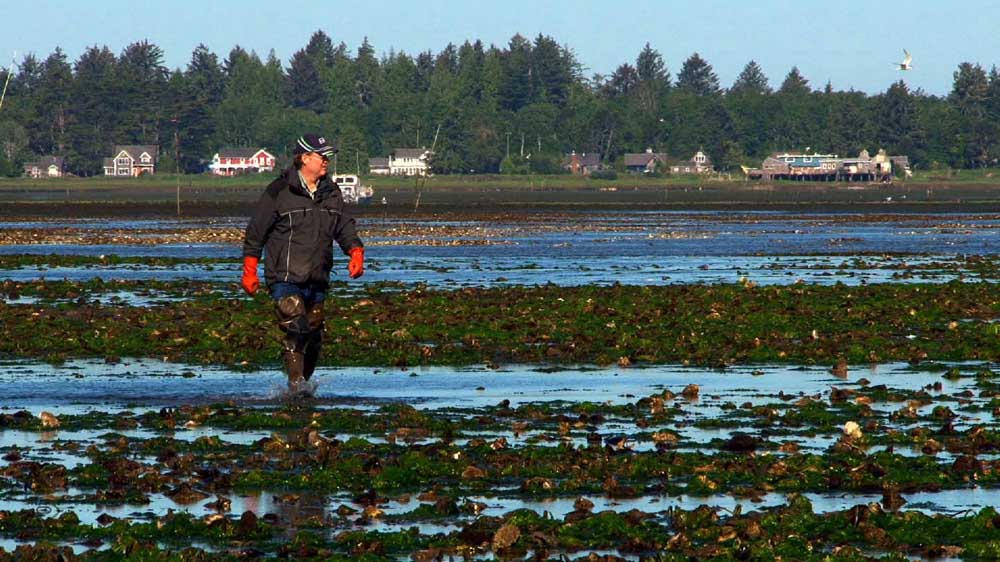‘Big chill’ ahead for Willapa shellfish State Health mandates rapid cooling for harvested oysters
Published 6:17 am Thursday, April 16, 2015

- Leading peninsula oysterman Fritz Wiegardt, pictured walking in one of his oyster beds, and other Washington state oyster growers will have to speed the time between harvest and product icing under a new regulatory scheme being implemented by the Washington State Department of Health.
PACIFIC COUNTY, Wash. — Starting May 1, oyster harvesters and processors across Washington will have to get their oysters on ice and cooled down in less than half the time they were allowed before. The rule change could significantly alter how the industry operates, but health officials argue it will do more to prevent shellfish-related illness.
Trending
Washington’s shellfish industry brings more than $270 million to the state’s economy and includes about 349 licensees who handle everything from oysters to hard-shell clams and geoducks. Of these licensees, about 150 deal with oysters during the summer months and will be the ones directly affected by the rule change.
The industry nationwide has operated under regularly updated control plans since 1997. These plans outline harvest methods, temperature control limits, environmental monitoring and more — all designed to reduce the risk of illnesses associated with the pathogenic form of a bacteria found in oysters, Vibrio parahaemolyticus. Vibrio can cause gastrointestinal illness in people who consume raw or undercooked oysters.
Under the new rule, inland and coastal operations will be broken into risk categories based on whether a certain number of vibriosis-related illnesses have been proven in an area in the last five years. All of the Willapa Bay and Grays Harbor growing areas are in the risk 1 category — the lowest risk.
Trending
They used to have 10 hours after oysters were exposed to air temperatures to get the product on ice and then 10 more hours to get them down to 50 degrees Fahrenheit, and only in July and August. But now, between the months of June and September, they will have nine hours total to get their oysters contained, cold and down to safe temperature.
Under the new rule, if air temperatures rise, those nine hours will drop to seven or even five hours. Operations could be shut down entirely if the weather gets hot enough.
“It is unlikely the coast would reach those temperatures,” said Laura Johnson, with the Washington State Health Department’s shellfish program in the office of environmental health and safety. Still, she added, the coast had an unusually warm and long summer last year.
“This summer could be tough,” she said.
The Vibrio bacterium becomes active at warmer temperatures after being exposed to the air. Outbreaks occur most often during the summer months. Any state that has had an outbreak is required to also have a control plan.
Washington has had two large outbreaks, one in 1997 and another in 2006, and 40 to 50 vibriosis-related illnesses can be traced back to the state’s commercial oyster harvest each year. For every single reported case, the Centers for Disease Control and Prevention estimates an additional 156 illnesses occur.
The control plans aren’t working, concluded researchers with the Washington State Department of Health. Over the years, there has been an increase in coastal illnesses, especially in the month of September, they said.
Johnson said Washington’s new rule seeks to use temperature to be proactive versus reactive.
The newly defined risk category 1 operations have a wide window compared to the category 2 and category 3 operations. From May to September, category 2 operations will have seven hours from time of harvest to cooling; category 3, which includes a number of inland operations, will have only five hours.
“We here are lucky we’re risk category 1,” said Monica Pine, plant manager for Bay Center Mariculture in Bay Center.
Still, the rule change could mean significant investment in new infrastructure or changes in harvesting and buying practices for some companies — and it guarantees a lot more paperwork for everyone.
The Port of Peninsula, for example, immediately began planning to invest in a commercial ice machine capable of producing 20,000 pounds of flake ice daily after the rule was adopted in March. While individual operations might have small ice machines, there was nothing in the area that could generate quite so much ice, said Jay Personius, the port’s economic development officer.
It would be impossible for “business as usual to continue in the oysterfields this summer without hundreds of tons of ice,” Personius said.
The port plans to make the ice available at market rates in 500-pound totes to area businesses and individuals, but priority goes to the shellfish operations affected by time and temperature regulations.
Johnson is traveling from training to training but companies have only a few more weeks to get everything in place that they’ll need in order to comply with the new rule. Companies will have two options when it comes to taking temperatures when the oysters first leave the water: they can take the water temperature at the depth of the oysters being harvested or they can take meat temperature from an oyster.
In general, Pine and others believe larger companies might struggle more with the rule change, especially if they are getting oysters from a variety of harvesters.
Everyone at the training Pine attended was “hem and hawing” about what they would do, Pine said.
“I think this first year is going to be trial and error for most of us, including the health department to see how it works,” Pine said. “…This first year they’re being lenient on everyone because it’s new.”








